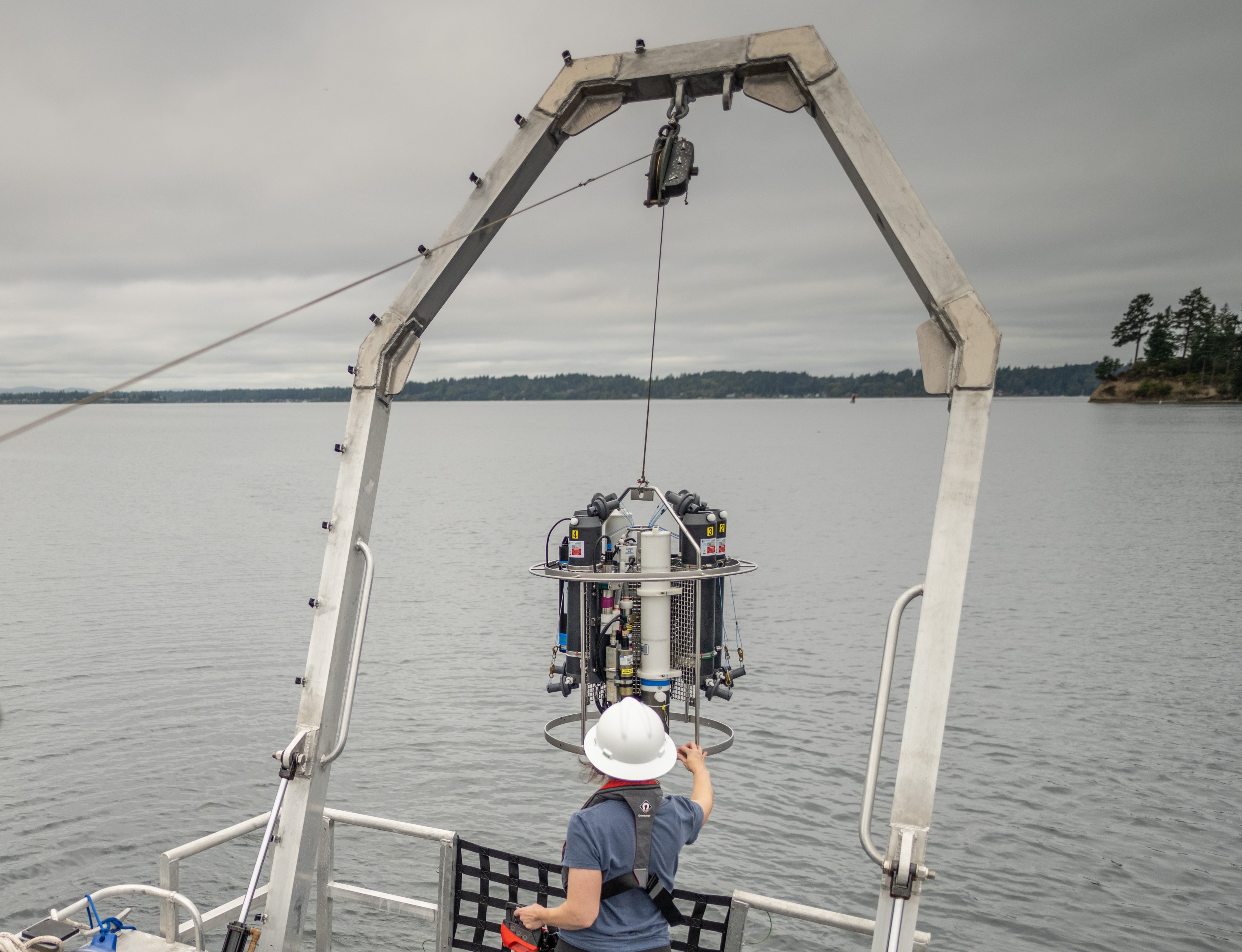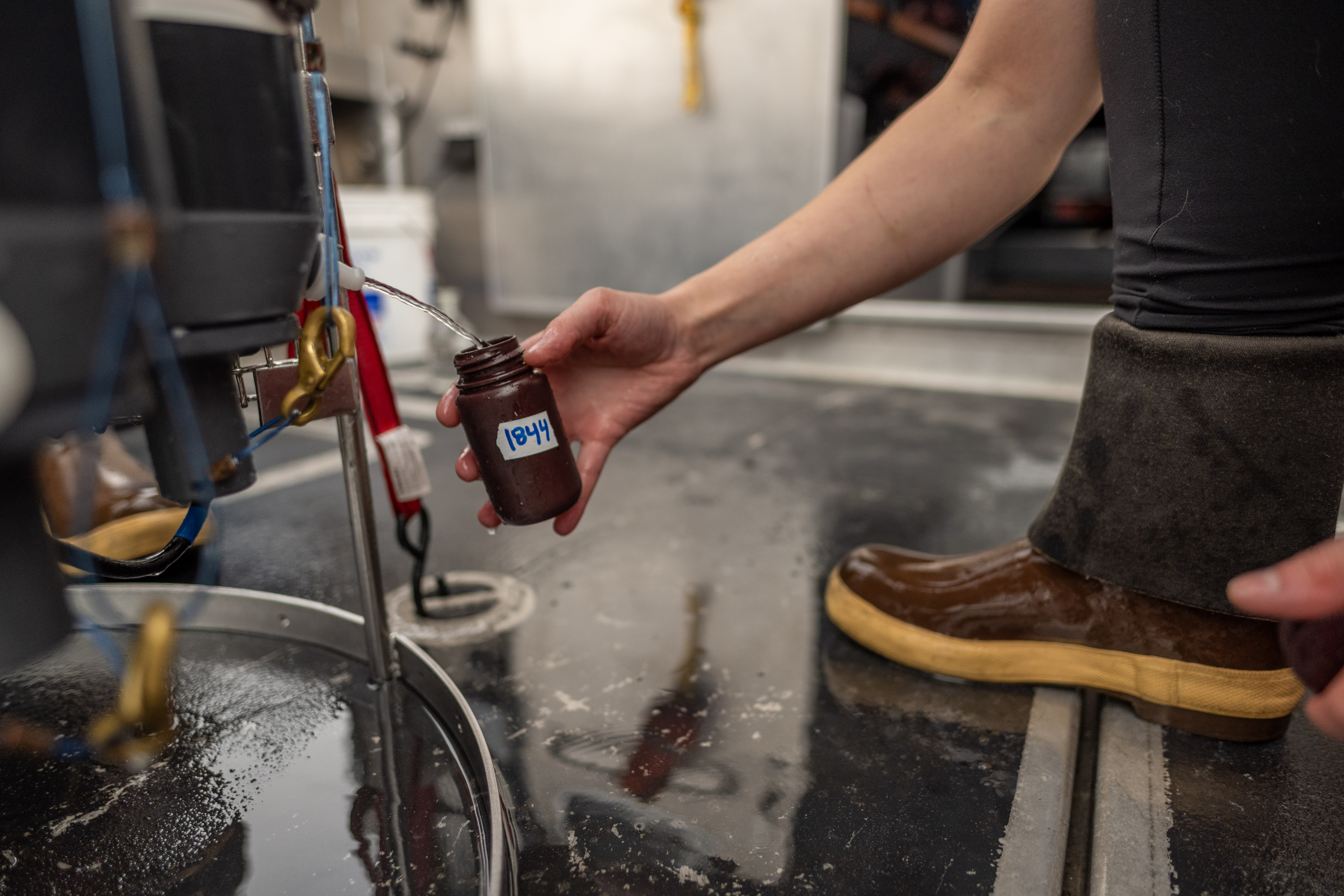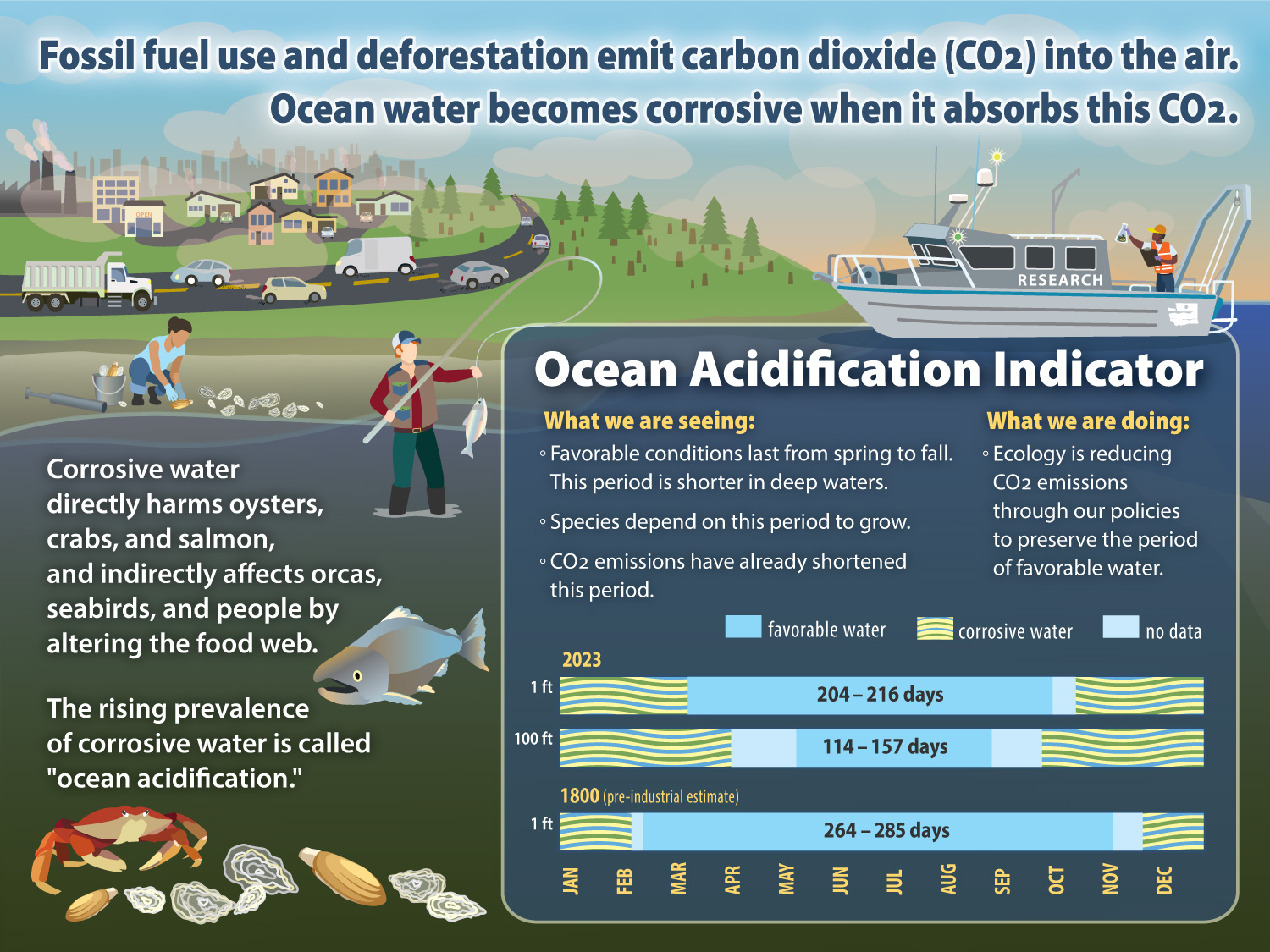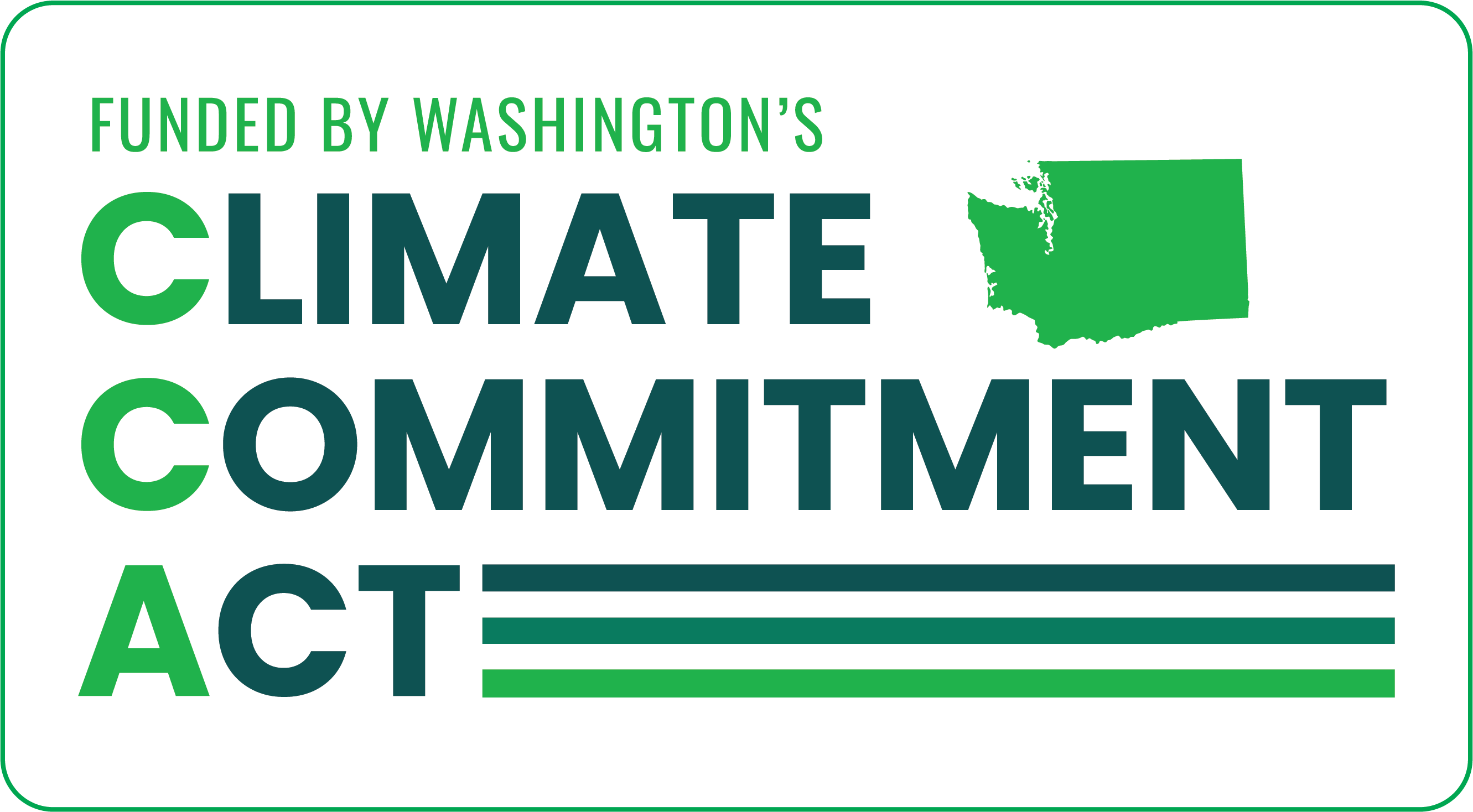
Ecology's marine scientist launches a CTD device (Conductivity, Temperature, and Depth) to collect data on water conditions in Puget Sound.
Shellfish are a good source of nutrition, and many people enjoy harvesting and eating them. Oysters, razor clams, and mussels have long been food sources for Washingtonians. They’re an integral part of local traditions and livelihoods. Many shellfish are also filter-feeders, which means they help keep water clean.
But these animals are in trouble. Carbon pollution from human activities is turning their home — the ocean — into a hostile environment because of ocean acidification. To help communities adapt, we created an ocean acidification indicator to visualize changing marine water conditions in Washington state. An “indicator” is a simply presented data reference tool used by scientists to communicate complex information.
“Ocean acidification, like climate change, is caused by carbon pollution worldwide. It’s a daunting problem. It’s also within our power to protect the future of the ocean,” said Micah Horwith, Ecology’s ocean acidification senior scientist.
What is ocean acidification? In short, the ocean is becoming more corrosive (acidic) as it absorbs carbon dioxide, a type of greenhouse gas emitted by burning fossil fuels and deforestation. Corrosive water disrupts the delicate balance of marine habitats, making survival more difficult for shellfish and salmon. Ocean acidification also alters the food web, indirectly affecting orcas, seabirds, and people.
If carbon dioxide emissions continue to increase, ocean acidification could cause long-lasting impacts by further changing the ocean’s chemistry. Other climate change stressors, such as warmer waters and less oxygen in the water, add to the threats experienced by marine plants and animals.
It’s all incredibly concerning, but it’s not an impossible problem to address; research and policy are leading to solutions.
Tracking ocean acidification
Our long-term ocean acidification monitoring program, established in 2019, tracks how carbon pollution affects marine waters. We measure water conditions monthly at 28 locations in Puget Sound and along the coast. For each location, we sample water at the surface and at 100 feet, which tells us how acidification conditions change with depth.
Our scientists conduct research onboard R/V Salish Seacat. They collect water samples throughout Puget Sound and along the coast.
Our measurements let us estimate a water property called aragonite saturation state. Aragonite is a form of calcium carbonate that many marine organisms produce to build their skeletons and shells. The lower the saturation state, the more difficult it is for shellfish and salmon to build and maintain their protective skeletons and shells. This effect will worsen as ocean acidification shifts the ocean’s chemistry.
Data from our long-term monitoring stations are helping us create an accurate picture of ocean acidification in Washington.
Making an invisible problem visible
Using over four years of monitoring data, we created the Ocean Acidification Indicator to visualize annual ocean acidification conditions and to track the long-term effects of carbon pollution in greater Puget Sound. The indicator represents the number of days in each year when water conditions are favorable for sensitive marine animals. Think of it as a window of opportunity for oysters, crabs, and young salmon to grow and thrive.
Our research helps us pinpoint two annual timeframes:
- The range of days when water conditions are favorable, which is the ocean acidification indicator
- The range of days when water conditions are corrosive, making it more difficult for shellfish and salmon to thrive
Ocean chemistry is shifting because of carbon emissions. Our data show seasonal changes in greater Puget Sound. Water conditions are favorable for shellfish and salmon from spring to summer, and unfavorable from fall to winter. Favorable conditions have declined since the early 1800s.
What have we learned by tracking and studying ocean acidification in Washington? Puget Sound and the coastal environment are changing rapidly because of carbon pollution.
- There are seasonal changes in Puget Sound when favorable conditions for shellfish and salmon begin in spring and continue through most of the summer.
- Water in deep parts of Puget Sound and the coast is more corrosive than water in shallow areas, increasing stress for organisms near the seafloor like Dungeness crabs and oysters.
- Some regions of Puget Sound are more at risk because ocean acidification is worsening naturally occurring corrosive conditions.
The more we learn, the more we can share with our partners to help them adapt and adjust management practices. We’re sharing our data with Tribes, shellfish farmers, resource managers, policymakers, and scientists throughout the state and the west coast.
Shellfish farmers can use the indicator to track months when water conditions are better for growing shellfish. Resource managers and policymakers can evaluate whether they need to adjust management practices. Scientists and research partners can build on our data to develop new tools or studies to better understand ocean acidification and forecast future conditions.
We strive to support thriving shellfish communities and healthy ocean habitats by sharing this information and coordinating with our partners.
Reducing greenhouse gas emissions
We can limit ocean acidification and climate change by addressing the source: carbon pollution.
Ocean acidification threatens Washington’s $270 million shellfish industry — the largest on the west coast — as well as Tribal customs and sovereignty. Ocean waters on the outer coast of Washington and the Puget Sound have become 10-40% more corrosive since 1800, which is already negatively affecting some shellfish species. If we continue with business-as-usual, our ocean waters are expected to become at least 100% more corrosive by 2100 compared to 1986-2005 levels.
“As ocean acidification science progresses, it’s been remarkable to learn that different species have different responses to what we expect the ocean to look like in the future,” Horwith said. “Some species are highly sensitive to changes in the ocean, while some are more robust. It’s complicated thinking about how marine ecosystems will shift as water becomes more corrosive. This is why we need sustained action to support healthy marine habitats.”
As ocean acidification worsens due to climate change, we are taking action through several greenhouse gas reduction policies, including the Climate Commitment Act (CCA). The CCA plays a key role in making sure Washington reduces greenhouse gases to net zero by 2050 — a statutory commitment that’s based on the latest climate science. In addition to cost-effectively lowering greenhouse gas emissions, the CCA generates revenue to address the impacts of climate change, like ocean acidification. 
The CCA is part of a suite of policies our state has enacted to address climate change. And though we can’t solve climate change on our own, it’s important that we do our part. Our state’s leadership is generating momentum across the nation as other states consider adopting similar policies. With policies like the CCA, we have a chance to limit the impacts of climate change and ocean acidification and preserve a window of opportunity for sensitive species in Puget Sound.

